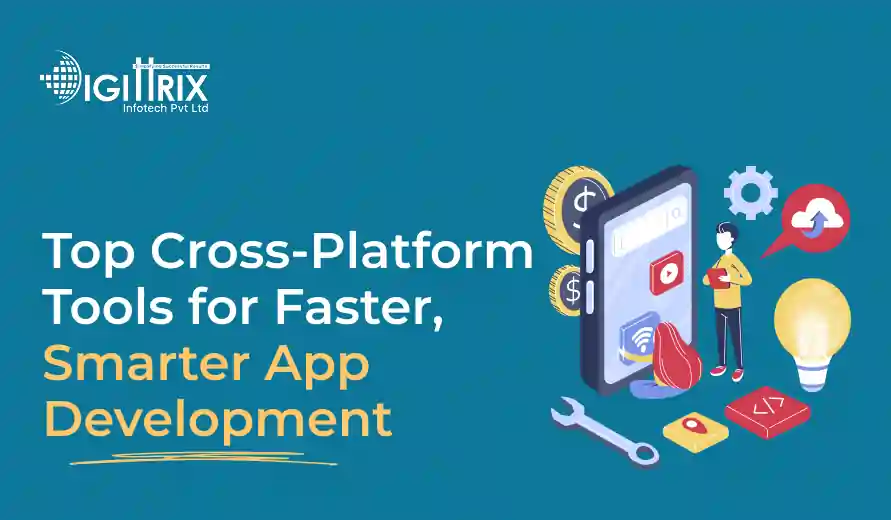Cross-platform tools accelerate app development by using a single codebase for multiple platforms, helping developers save time, lower costs, and ensure consistent user experiences.
Highlights
With Over 14 years of Experience in the IT Field, Helping Companies Optimise there Products for more Conversions

In today's digital age, businesses, startups, and independent developers are looking for ways to create mobile applications more efficiently while reaching a wider audience. Mobile app development has become essential for business growth, allowing companies to deliver services, communicate with customers, and offer solutions directly through smartphones. However, building separate apps for Android and iOS can be time-consuming and expensive. Cross-platform development tools solve this problem by enabling developers to write a single codebase that runs on multiple platforms, saving time, reducing costs, and simplifying maintenance.
This article explains the most popular cross-platform tools for app development, how they work, and why many developers and app development companies choose them.
Curious about what frameworks dominate mobile app development in 2025? Read Digittrix’s guide to top frameworks this year to see what’s leading the pack!
Cross-platform app development refers to creating applications that run on more than one operating system, typically Android and iOS, using a single codebase. Unlike traditional methods, which require separate development for each platform, cross-platform frameworks let developers write code once and deploy it across multiple devices.
This approach has many advantages. It reduces the cost of custom app development, accelerates the development timeline, and ensures consistency across platforms. On-demand app development projects like ride-sharing apps, food delivery apps, and service booking apps often use cross-platform tools to reach users quickly on both Android and iOS devices.
Several cross-platform frameworks are available today, each with unique features and benefits. The choice depends on project requirements, developer skills, budget, and performance needs.
Flutter, developed by Google, is an open-source framework that allows developers to create apps for Android, iOS, and even desktop platforms using a single codebase written in Dart.
Flutter is excellent for businesses working with an app development company that wants to create high-performance apps quickly. Both Android app developers and iOS app developers can use Flutter to share most of the code between platforms. Many on-demand app development projects, such as delivery and e-commerce apps, use Flutter for its speed and flexibility.
React Native, developed by Facebook, allows developers to build mobile apps using JavaScript and React. It enables apps to run on both Android and iOS devices.
React Native is ideal for custom app development because it allows fast prototyping and easy integration with backend services. App development services providers often choose React Native as it balances development speed with app quality. Android and iOS app developers can efficiently handle cross-platform projects, especially for on-demand app development.
While mainly known for game development, Unity can also be used for interactive applications and augmented reality (AR) apps across platforms.
Unity is often used by app development companies for gaming or AR-based applications. Android and iOS app developers can build apps with high interaction, visual effects, and animations. On-demand app development in gaming, education, and simulations benefits from Unity’s capabilities.
Xamarin, by Microsoft, uses C# for cross-platform development and enables developers to create native-like apps for Android, iOS, and Windows using one codebase.
Xamarin is chosen by app development companies focusing on enterprise apps and secure, high-performance applications. Android and iOS app developers can maintain consistent functionality and design across devices.
KMM, introduced by JetBrains, lets developers share code between Android and iOS while keeping platform-specific code when needed.
KMM works well for companies focusing on custom app development with a preference for native performance. Android and iOS app developers can reduce duplicate code while building apps with fully native behavior. On-demand app development, especially for apps handling complex logic or data, benefits from KMM.
NativeScript allows developers to create mobile apps using JavaScript, TypeScript, or Angular. It provides direct access to native APIs, offering better performance than traditional hybrid apps.
NativeScript is ideal for functional apps that require speed and responsiveness. App development companies choose NativeScript for on-demand mobile apps such as service booking or business solutions. Android and iOS app developers can efficiently build apps with consistent performance across devices.
Want your app to get discovered more often? Check out Digittrix’s list of top ASO tools and boost your app store visibility!
Cross-platform development tools are crucial in modern mobile app development. They allow developers and app development companies to build applications for multiple platforms using a single codebase, reducing costs and development time. Tools like Flutter, React Native, Xamarin, Ionic, PhoneGap, KMM, Unity, and NativeScript offer unique benefits depending on project requirements and performance needs.
Businesses can use these frameworks for mobile app development, custom app development, or on-demand app development services. Android and iOS app developers can focus on creating user-friendly applications while ensuring consistent functionality across devices. Selecting the right cross-platform framework helps businesses and developers complete projects faster, reduce expenses, and deliver high-quality mobile experiences.
Create powerful and cost-effective applications using the best cross-platform tools for faster, smarter app development. At Digittrix, we use frameworks like Flutter, React Native, and Xamarin to build apps that run smoothly on both Android and iOS. These tools offer scalability, consistent performance, and wide platform support, helping you launch your app efficiently and affordably.
Whether you need an on-demand mobile app or a custom business solution, our expert developers guide you through every step. With over 14 years of experience, Digittrix is a trusted mobile app development company for creating high-quality applications using the latest technologies.
If you’re planning to build a cross-platform app and want guidance to get started, schedule your consultation with our technical managers today. Call +91 8727000867 or email digittrix@gmail.com for all your app development queries.

Do you need help in Mobile App development?




Join over 1500+ businesses we've already helped!
It refers to building applications that can run on multiple operating systems using a single shared codebase.
Flutter and React Native are widely used because they offer fast performance and allow developers to build for multiple platforms easily.
It saves time, reduces development costs, and allows apps to reach a wider audience across different devices.
Yes, with modern frameworks, apps can achieve performance levels and user experiences close to native applications.
Consider the project’s size, required features, performance needs, and the experience level of your development team.

©2025Digittrix Infotech Private Limited , All rights reserved.